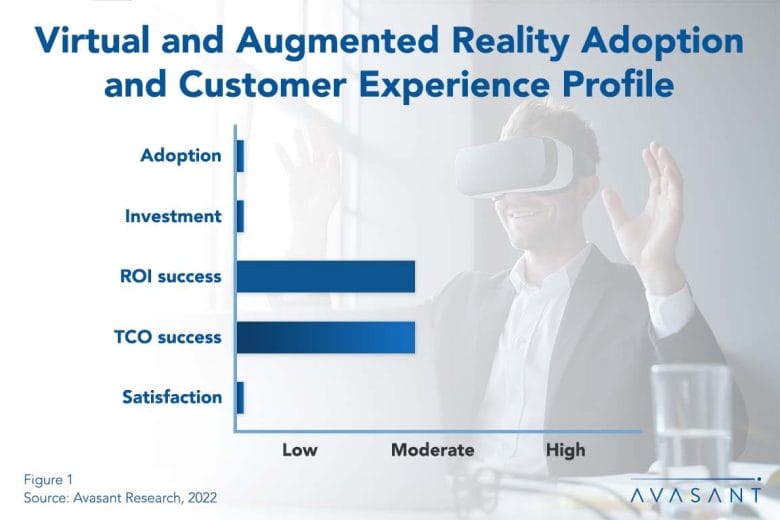Virtual reality (VR) and augmented reality (AR) are emerging technologies that will change the nature of work in many industries. Professionals such as doctors, mechanics, and engineers can use VR and AR to map out solutions before implementing them in the real world. This minimizes human errors and increases worker efficiency. These technologies will also be important tools in the hybrid work environment, as more use cases emerge for training and collaboration with customers, suppliers, and employees.
As seen in Figure 1 from our full report, Virtual and Augmented Reality Adoption Trends and Customer Experience, VR and AR currently have low adoption, investment, and satisfaction rates. On the other hand, two other metrics—ROI and TCO—are moderate. While the growth in enterprise VR and AR is slower than most of the other technologies we survey, early adopters are seeing moderate success rates. With moderate economic success rates and investments by companies such as Facebook (Meta), Nvidia, and Microsoft, VR and AR growth is likely.

While the technologies are quite similar, there are differences. VR is a computer-generated simulation usually using a headset designed to immerse the user entirely in the simulation. In contrast, AR causes the device to overlay the simulation onto the real world instead of immersing the user entirely in the simulation. This difference has resulted in a pull toward AR as a business solution. And we expect business use of AR to outpace that of VR in the next three to five years.
For example, AR has already found applications in real estate. The Commercial Real Estate AR app allows a real estate agent or buyer to view a block of apartment buildings through a smartphone with its AR application, which can display the location of available apartments and their monthly rental prices. AR triumphs due to its accessibility to the consumer—the mobile phone.
In addition, many workplace collaboration tools are adopting AR tools such as face filters, virtual whiteboards, and note-taking tools. Nevertheless, VR has its strengths, such as in training environments. For example, Walmart uses VR headsets to train its associates.
“Although mainstream adoption rates for VR and AR are low, consumer- and enterprise-ready technologies are likely to change this in the near future,” said Tracell Frederick, research analyst/editor for Computer Economics, a service of Avasant Research, based in Los Angeles. “VR and AR are building momentum to revolutionize sectors like healthcare, manufacturing, and especially asset-intensive industries.”
Our full report quantifies the current adoption and investment trends for VR and AR, as well as the benefits driving companies to expand their VR and AR implementations. We assess these trends by organization size, sector, and geography and look at the ROI and TCO experiences of organizations that have adopted this technology. We conclude with practical advice for those planning new investments in VR and AR.
This Research Byte is a brief overview of our report on this subject, Virtual and Augmented Reality Adoption and Customer Experience. The full report is available at no charge for subscribers, or it may be purchased by non-clients directly from our website (click for pricing).




